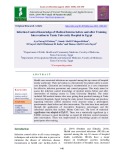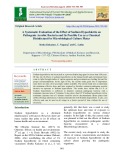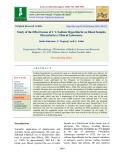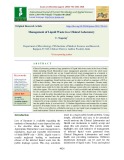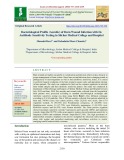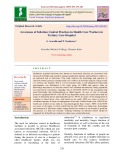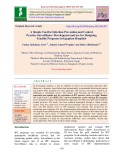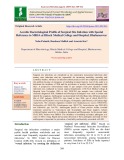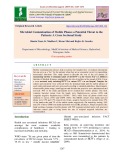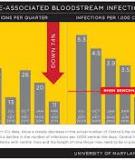
Hospital infection control practices
-
This study aimed to assess the infection control knowledge of medical interns before and after intervention of training course in Tanta University Hospital. The study included 268 medical interns who were getting their practical training at Tanta University Hospitals, Egypt during the study period. Knowledge and practices regarding infection control measures were assessed using a predesigned questionnaire sheet before and after intervention.
 11p
11p  chauchaungayxua12
chauchaungayxua12
 29-07-2021
29-07-2021
 13
13
 2
2
 Download
Download
-
Pseudomonas aeruginosa is a classical opportunistic pathogen with innate resistance to many antibiotics and disinfectants. Clinical samples which yielded Pseudomonas aeruginosa were included in this study. Antibiogram of the isolates was determined by Kirby-Bauer disc diffusion method. A total of 339 pseudomonas aeruginosa were isolated from various clinical samples during the period of study. Majority of the isolates in our study were obtained from Pus / Wound swabs followed by other samples. Resistance to amoxicillin +Clavulinic acid (74.
 6p
6p  quenchua6
quenchua6
 15-06-2020
15-06-2020
 11
11
 2
2
 Download
Download
-
Sodium hypochlorite has been used as a proven disinfecting agent for more than 150 years. Of late, the ill effects of sodium hypochlorite on the human health and environment have come to light through studies of various agencies and governments are looking forward for proper recommendations. In the light of this, the current study gains lots of importance since there are only a few systematic studies available.
 7p
7p  trinhthamhodang1213
trinhthamhodang1213
 30-05-2020
30-05-2020
 5
5
 0
0
 Download
Download
-
Sodium hypochlorite is extensively used as a disinfectant in the health care industry for more than 150 years. There are lots of misconceptions are there even to this day regarding the dilution and time of exposure required for its disinfection action. National guideline on Biomedical waste published by the Ministry of Government of India in its recommendations on Biomedical Waste (BMW) rule of 2016 had suggested the use of 10 % Sodium hypochlorite which was later corrected as typographical error and changed to 1 % which is now followed in the BMW Rule – 2018.
 6p
6p  caygaocaolon5
caygaocaolon5
 27-05-2020
27-05-2020
 17
17
 1
1
 Download
Download
-
Clinical Laboratory produces large quantities of liquid infectious waste in the form of body fluids including blood. Biomedical waste management generally covers the solid waste generated in the Health care set up. Liquid infected waste management in a hospital is mainly addressed in the form of Sewage treatment plant (STP) or Effluent treatment plant (ETP) which is made mandatory for hospitals. Construction of these facilities involves lot of financial expenditure. Small facilities may not be able to afford to construct a STP or ETP in their facility.
 5p
5p  caygaocaolon5
caygaocaolon5
 27-05-2020
27-05-2020
 14
14
 0
0
 Download
Download
-
Burn wounds are highly susceptible to colonization and infection which creates obstacle in proper management of burn victims. Since burn wound infection shows changing trends in pathogenicity of microorganisms as well as their antibiotic sensitivity, hence, it is crucial to perform frequent evaluation of the burn wound to ensure early and appropriate therapy in burn patients. The study was conducted to find out the common organisms in infected burn wound samples and their antibiotic sensitivity pattern.
 10p
10p  trinhthamhodang5
trinhthamhodang5
 16-05-2020
16-05-2020
 19
19
 1
1
 Download
Download
-
Over staying in hospital due to postoperative suture line infection is burdening to every system, a well-known fact. The uniformly nonobligatory infection control policy frame work specially in developing nation like India, causes poor participation by administration to implement the proper infection control practice until the impact of postoperative infection burden is measured.
 6p
6p  nguathienthan4
nguathienthan4
 18-04-2020
18-04-2020
 20
20
 1
1
 Download
Download
-
Healthcare acquired infections also known as nosocomial infection are associated with increased morbidity and mortality among hospitalized patients and healthcare workers to an increased risk of infections. This study explores the knowledge and practices of infection control practices among health care workers in Saveetha medical college which is a tertiary care hospital. This is a cross-sectional study. A self-administered structured questionnaire was distributed to the study group (of CRRIs and nurses). Data on knowledge and practice of infection control were obtained and analyzed.
 6p
6p  caygaocaolon3
caygaocaolon3
 27-02-2020
27-02-2020
 40
40
 3
3
 Download
Download
-
In developing countries, it may be difficult to survey for nosocomial infections (NI). Moreover, a structure- based rather than internationally recommended infection prevention and control (IPC) programs are more applicable. IPC practice surveillance could be an additional or substituent survey. The current work describes the development of a measurable and updated tool for surveillance of IPC practices which we called “Ranked IPC Audit Check- Lists (RIPCACL)” and to evaluate their use for tailoring IPC programs in two hospitals in Egypt.
 10p
10p  kequaidan2
kequaidan2
 11-12-2019
11-12-2019
 18
18
 0
0
 Download
Download
-
Surgical site infections are considered as the commonest nosocomial infections after urinary tract infections and are responsible for increasing morbidity, mortality and economic burden. Advances in infection control practices have not completely eradicated this problem because of emergence of multidrug resistant bacteria. Aim of the study is to determine the incidence of SSIs and the prevalence of aerobic bacterial pathogens with their.
 6p
6p  nguaconbaynhay1
nguaconbaynhay1
 08-12-2019
08-12-2019
 15
15
 1
1
 Download
Download
-
Microbial contamination of mobile phones a potential threat to the patients: A cross sectional study
Mobile communication devices help accelerate the hospital flow of medical information but can serve as a "foe" for the patients when they act as a potential vector for transmitting nosocomial infections. This study aimed to describe the role of the cell phones in transmitting bacteria to dominant hands of the HCW’s in the various ICU’s as MediCiti Institute of Medical Sciences, emphasizing the role of mobiles in the spread of HAI. It was a cross-sectional study including HCW’s at various ICU’s in our hospital.
 8p
8p  nguaconbaynhay1
nguaconbaynhay1
 04-12-2019
04-12-2019
 18
18
 0
0
 Download
Download
-
In 2010, an estimated 16 million operative procedures were performed in the United States.1 A recent prevalence study found that SSIs were the most common healthcare-associated infection, accounting for 31% of all HAIs among hospitalized patients.2 NHSN data for 2006-2008 (16,147 SSIs following 849,659 operative procedures) showed an overall SSI rate of 1.9%.
 21p
21p  giamdocamnhac
giamdocamnhac
 06-04-2013
06-04-2013
 72
72
 6
6
 Download
Download
-
An estimated 41,000 central line-associated bloodstream infections (CLABSI) occur in U.S. hospitals each year.1 These infections are usually serious infections typically causing a prolongation of hospital stay and increased cost and risk of mortality. CLABSI can be prevented through proper insertion techniques and management of the central line. These techniques are addressed in the CDC’s Healthcare Infection Control Practices Advisory Committee (CDC/HIPAC) Guidelines for the Prevention of Intravascular Catheter-Related Infections, 2011.
 17p
17p  giamdocamnhac
giamdocamnhac
 06-04-2013
06-04-2013
 56
56
 7
7
 Download
Download
CHỦ ĐỀ BẠN MUỐN TÌM









